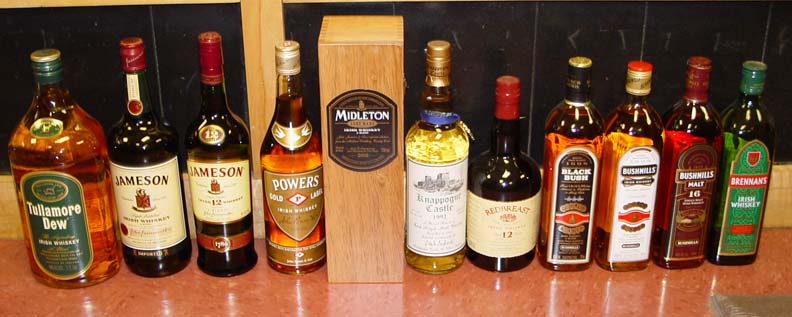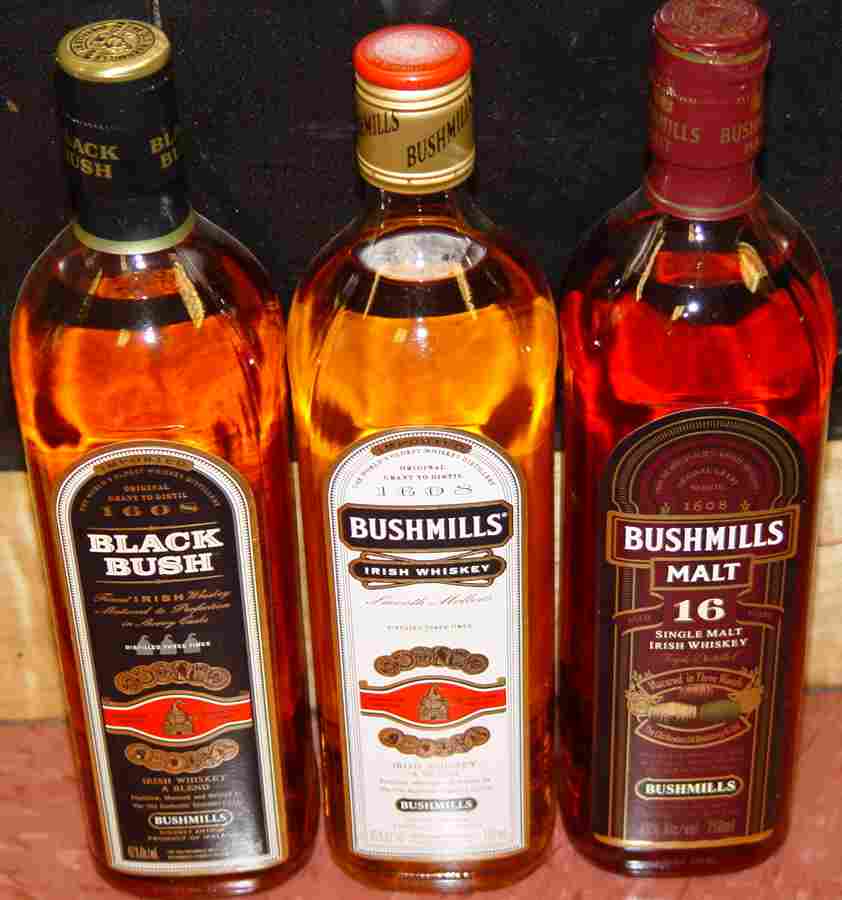|
Number 727, 2004 by Seamus P. O'Connor |
“Uisce Beatha Eireannach” |
Identification Legal Clusters Geographic Clusters Trade Clusters Other Clusters |

|
Number 727, 2004 by Seamus P. O'Connor |
“Uisce Beatha Eireannach” |
Identification Legal Clusters Geographic Clusters Trade Clusters Other Clusters |

The Issue
The Irish have always enjoyed two things: their drink and a good controversy. Irish Whiskey is a subject that incorporates these two issues. This case study will address Irish whiskey and its status as a geographic indication. At issue is the official labeling of a product based on its origin in a specific region and its production following specific rules. Geographic indicators have drawn controversy over the years bringing into question the necessity of their existence. The Irish have protected Irish whiskey through agreements with the EU. In accordance to the protection no other country or region can produce "Irish" whiskey.
Description
"Uisce Beatha" means "water of life" in the Irish language. When the Normans invaded, back in the 12th Century, they could not pronounce the words so they used "fuisce"--which over the years has evolved into the word whiskey. It is believed that by the time the Normans invaded, the Irish had been making whiskey for almost seven centuries. Ask any Irishman and he'll tell you that the Irish invented whiskey among other other things. The legends of St. Patrick attest to the Chrisitans bringing the art of distilling grain to Ireland. Due to the lack of written records no one knows for sure whether it was the Irish or the Scots who first made whiskey, so the debate still lives on.
Over time Irish whiskey became very prevalent throughout Ireland and the British Empire, in fact, throughout the 1800's there were over 2000 distilleries in Ireland. At the end of the Nineteenth century Ireland had about 90 percent of the global export market on whiskey. But, it soon was hit hard by a series of events including US Prohibition, English trade embargoes (because of the Irish independence movement), a global depression and World War Two. Begining in 1916 when the Irish war for independence strenthened the Britished issued a trade embargo which greatly curtailed exportation. Scotchy whisky, which was much cheaper because of a different means of production (a continuous distilling process), also put a serious damper on Irish sales. Simultaneously, in the United States the market was closed due to Prohibition between 1920 and 1933.
When WWII occurred Ireland was a neutral country. Because of its neutrality US soldiers were not allowed there when stationed in the UK and many began to acquire a taste for Scotch whisky at that time. Following the war when markets opened back up, Irish distillers had lost a lot of their market share and many customers to Scotch whisky.
By the 1960's only a handful of distilleries remained. Jameson, Power, and Cork distilleries in southern Ireland merged together forming the Irish Distillers Group.They began distilling near the Cork plant in southern Ireland. Bushmill's, a whiskey distiller located in Northern Ireland, with its claims of being "the oldest distillery in the world," joined the group in the 1972 dispelling the green (Ireland) and orange (Northern) rivalry--at that time all of Ireland's famed whiskeys were made at one of two distilleries, the Jameson distillery in Midleton near Cork in the south and the Bushmills distillery in County Antrim in the north. A really ironic fact is that the Irish Distillers Group is now a subsidiary of the French Pernod Ricard group.
Legislation was passed soon after to protect the production of Irish whiskey. The Irish Whiskey Act of 1980 states that—the spirits have to be distilled in the Republic of Ireland or in Northern Ireland and that the spirits have been matured in wooden casks in a warehouse in the Republic of Ireland or Northern Ireland for a period of no less than 3 years. Although steps were taken to protect Irish whiskey, its production and sales remained stagnant. But, in 1987, a development took place in the world of Irish whiskey. A newly formed company, called Cooley Distillery, bought an alcohol plant and installed two distilleries. Though undercapitatlized at first, Cooley's has done a tremendous favor to the rejuvination of Irish whiskey's popularity, by increasing competition and available brands.
Today things look to be brightening up for Irish Whiskey. Though a relatively small player, with just two companies distilling and global sales of around 30 million bottles last year, it has shown double-digit growth nearly every year for the last decade, a time when global whiskey sales have been largely static.
How it is Made
Three ingredients are needed to make whiskey: barely, water and peat
Take a virtual tour of the Jameson Distillery, the Bushmills Distillery, or the Middleton Distillery via www.whiskeytours.ie
Related Cases
| Irish
Potato Famine : overview of the impact of the Irish Potato Famine. |
Irish
Music : WTO dispute with regard to US copyright standards. |
Irish
Fishing Quotas : EU requirement to protect fishing. |
| Sellafield
Nuclear Power Plant : Environmental issues in the Irish Sea. |
Mexican
Tequila : Tequila has become protected as a geographical indication. |
Grappa
: Dispute over the production of grappa. |
| German
Beer : Purity laws and the requirements to get into the German beer
market. |
Bacardi
: Ownership dispute over the rights to Havana Club rum. |
Baiju
: China's alcohol industry on the verge of an open market. |
| Mexbrew
: Mexico vs. Miller Brewing Co. over cinco de mayo. |
Pisco
: Dispute between Peru and Chile over Pisco. |
Scotch
: Protection of Scotch whisky by law. |
| Budweis
: Dispute between Czech and US brewers over the right to name a beer Budweiser. |
Whine-pact
: A multi-lateral agreement on whine products. |
Zinfandel
: US and Italian argument over naming rights for a whine. |
Author and Date
Seamus Padraic O'Connor May 2004
AN IRISH TOAST: |
"May
your glass be ever full. May the roof over your head be always strong. And may you be in heaven half an hour before the devil knows you're dead." |
Discourse and Status: Agreement and Complete
Irish whiskey is a protected geographical indication within the EU and other countries such as Canada and the United States. Laws recognize that there are specific requirements and regulations for the production of Irish whiskey. In Ireland the Irish Whiskey Act of 1980 states that—the spirits have to be distilled in the Republic of Ireland or in Northern Ireland and that the spirits have been matured in wooden casks in a warehouse in the Republic of Ireland or Northern Ireland for a period of no less than 3 years.
Forum and Scope: EU and Regional
Decision Breadth: 15 Members of EU
Legal Standing: Treaty
Irish National legislation protecting spirits:
|
• Irish Whiskey Act, 1980 (No. 33 of 1980) |
|
• European Communities
(Definition, Description and Presentation of Spirit Drinks) Regulations, 1995 (S.I. No. 300 of 1995) |
|
• European Communities
(Definition, Description and Presentation of Spirit Drinks) (Amendment) Regulations, 1996 (S.I. No. 60 of 1996) |
|
• European
Communities (Definition, Description and Presentation of Spirit Drinks) (Amendment) Regulations, 1998 (S.I. No. 7 of 1998) |
Likewise, the EU has made a series of agreements begining on May 29, 1989 identifying and protecting geographical indications including Irish Whiskey—“Uisce Beatha Eireannach”.
Council
Regulation (EEC) 1576/89 (OJ L160, p1, 12/06/89) of 29 May 1989 laying
down general rules on the definition, description and presentation of
spirit drinks. |
Commission
Regulation (EEC) 1014/90 (OJ L105, p9, 25/04/90) of 24 April 1990 laying
down detailed implementing rules on the definition, description and presentation
of spirit drinks. |
Commission
Regulation (EEC) No 2009/92 (OJ L203, p10, 21/07/1992) of 20 July 1992
determining Community analysis methods for ethyl alcohol of agricultural
origin used in the preparation of spirit drinks, aromatized wines, aromatized
wine- based drinks and aromatized wineproduct cocktails. |
Commission
Regulation (EC) 1267/94 (OJ L138, p7, 2/06/94) of 1 June 1994 applying
the agreements between the European Union and third countries on the mutual
recognition of certain spirit drinks. |
|
AN IRISH PROVERB: |
"It
is sweet to drink but bitter to pay for." |
 Geographic Clusters
Geographic ClustersGeographic Locations
Geographic Domain: Europe
Geographic Site: Ireland and Northern Ireland
Type of Habitat: Temperate
|
AN IRISH PROVERB: |
God
invented whiskey to keep the Irish from conquering the world! |
Type of Measure: Intellectual Property
Direct v. Indirect Impacts: Direct
Trade Product Identification:
In accordance with regulations, the spirits have to be distilled in the Republic of Ireland or in Northern Ireland and that the spirits have been matured in wooden casks in a warehouse in the Republic of Ireland or Northern Ireland for a period of no less than 3 years.
Economic Data
Today things look to be brightening up for Irish
Whiskey. Though a relatively small player, with just two companies distilling
and global sales of around 30 million bottles last year, it has shown double-digit
growth nearly every year for the last decade, a time when global whisky sales
have been largely static.
Impact of Trade Restriction: High
Industry Sector: Food
Exporters:
Ireland and UK
Importers: Many
|
AN IRISH TOAST: |
May God give you good luck and put a good man in your
way, and if he is not good, may the wedding whiskey be drunk at his wake.
Sláinte! |
 Other
Factors
Other
FactorsCulture: Yes
When many people think of the Irish they think of the stereotypical Irishman drinking at a pub (public house). But, Irish pubs are places for more than just a drink. The pub plays a large social role in Irish life. It provides people a place to meet, to eat, to drink, to hear music and to relax. According to Ireland for Dummies pubs have a long cultural history: "Going back to the Middle Ages, Irish pubs began as places for merchants and travelers to replenish themselves with a drink. Later, when the strong arm of Britain was upon Ireland, these watering holes flourished even though they'd been declared illegal, serving as a wonderful escape from the colonial tyranny. Later, in Victorian times, pubs went from being drab and dark to being beautifully decorated, and many of the older establishments still bear their original counters and elaborate windows."
Likewise, the role of the pub has evolved over the years. In years past, pubs in small towns also played the role of grocery store--even today some pubs carry on the tradition. Pubs have also played a major role in the history of Ireland. Often times pubs were the setting of meetings held by revolutionaries as they fought for Irish freedom. Also, pubs have been the inspiration for many Irish writers both as a place for them to escape to and for inclusions as settings in their stories.
Trans-Boundary Issues: No
Rights: Yes
Relevant Literature:
http://www.allaboutirish.com/library/foodbev/whiskey.shtm
March 21, 2004
http://www.emeraldtiger.com/general/irishvscots.htm
March 21, 2004
http://www.harpers-wine.com/featuresitem.cfm?FeatureID=98
March 24, 2004
http://cocktails.about.com/library/weekly/aa031299.htm
March 24, 2004
http://www.dummies.com/WileyCDA/DummiesArticle/id-823.html
April 3, 2004
http://www.corsinet.com/trivia/irish_toasts.html
April 10, 2004
http://www.corsinet.com/trivia/irish_proverbs.html
April 10, 2004
http://www.luquette.org/inspire/irish_blessings.htm
April 10, 2004
http://www.irishcultureandcustoms.com/2Kitch/aUisce.html
April 10, 2004
http://www.wto.org/english/news_e/news98_e/pu_e.htm
April 11, 2004
http://www.washingtonian.com/dining/whiskies.html
April 11, 2004
http://www.emeraldtiger.com/general/whiskeys.htm
April 12, 2004
http://www.classicwhiskey.com/
April 16, 2004
http://www.tullamoredew.com/special.htm
April 20, 2004